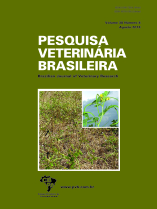 |
|
|
|
Year 2018 - Volume 38, Number 8
|

|
Modified TightRope technique for treatment of the cranial cruciate ligament disease in dogs: long term outcomes, 38(8):1631-1637
|
ABSTRACT.- Abreu T.G.M., Muzzi L.A.L., Camassa J.A.A., Kawamoto F.Y.K. & Rios P.B.S. 2018. [Modified TightRope technique for treatment of the cranial cruciate ligament disease in dogs: long term outcomes.] Técnica de TightRope modificada no tratamento da doença do ligamento cruzado cranial em cães: resultados a longo prazo. Pesquisa Veterinária Brasileira 38(8):1631-1637. Universidade Estadual Paulista “Júlio de Mesquita Filho”, Campus de Jaboticabal, Via de Acesso Prof. Paulo Donato Castellane Km 5, Jaboticabal, SP 14884-900, Brazil. E-mail: thaismorato@yahoo.com.br
The aim of the study was to describe the long term outcomes of the modified extracapsular TightRope (TR) technique in the treatment of the cranial cruciate ligament (CCL) disease in eight dogs (10 joints) with a body weight ranging from 4kg to 28kg. The animals were submitted to specific orthopedic examinations and were diagnosed with total CCL rupture by drawer and tibial compression tests. Conventional and stress positional radiographic examinations of the affected joints were performed. The TR technique was modified using the nylon suture thread replacing the fiber suture used in the original technique, which facilitated the availability of obtaining the material. There was also modification in the origin of the tibial tunnel perforation that was performed immediately cranial to the groove of the long digital extensor tendon. The dogs underwent radiographic examination in the immediate postoperative and in later periods. At one month after surgical procedure, the animals showed mild or moderate lameness in the affected pelvic limbs. Mild cranial tibial drawer was observed in 60% of the operated joints. At three months after the procedure, the animals have mild decrease in the range of joint motion, but without signs of pain. Two stifle joints (20%) showed a slight cranial displacement of the tibia in the drawer test. In this period, 80% of the affected joints showed normal limb support. At one year after the procedure, radiographic examination showed a discrete progression of the degenerative joint disease in 50% of the operated joints. The long term outcomes were obtained from eight joints and in only one pelvic limb was observed mild lameness with slight weight transfer to the normal contralateral limb. All other evaluated pelvic limbs (87.5%) showed no lameness and proper recovery of joint function. In conclusion, the modified TR extracapsular surgical technique proved to be effective as a treatment option for CCL disease in small and medium dogs, with no complications. Modifications of the surgical suture thread and the tibial site perforation of the TR technique seem to have positive effects on stabilization of the stifle joint. |
| |
|
|
| |
|
 |